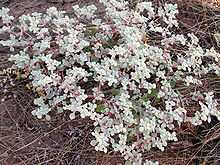Tidestromia
From Wikipedia, the free encyclopedia
| Tidestromia | |
|---|---|
 | |
| Tidestromia lanuginosa | |
| Scientific classification | |
| Kingdom: | Plantae |
| (unranked): | Angiosperms |
| (unranked): | Eudicots |
| (unranked): | Core eudicots |
| Order: | Caryophyllales |
| Family: | Amaranthaceae |
| Genus: | Tidestromia Standl. |
| Species | |
|
6 or 7 | |
Tidestromia is a genus with about six or seven species of annual or subshrub perennial plants native to desert and semi-arid regions of the western United States, Mexico and tropical America in the family Amaranthaceae. A common name of some species is honeysweet. The stems are reddish and contrast conspicuously with the silvery leaves. This genus is named for the botanist Ivar Tidestrom.[1][2]
Species include:[3]
- Tidestromia carnosa - fleshy honeysweet
- Tidestromia gemmata - TransPecos honeysweet
- Tidestromia lanuginosa - woolly tidestromia
- Tidestromia oblongifolia - Arizona honeysweet
- Tidestromia suffruticosa - shrubby honeysweet
Notes
- ↑ Flora of North America
- ↑ Jepson Manual: Tidestromia
- ↑ Tidestomia. USDA PLANTS Profile.
References
- Everitt, J.H.; Lonard, R.L.; Little, C.R. (2007). Weeds in South Texas and Northern Mexico. Lubbock: Texas Tech University Press. ISBN 0-89672-614-2
This article is issued from Wikipedia. The text is available under the Creative Commons Attribution/Share Alike; additional terms may apply for the media files.